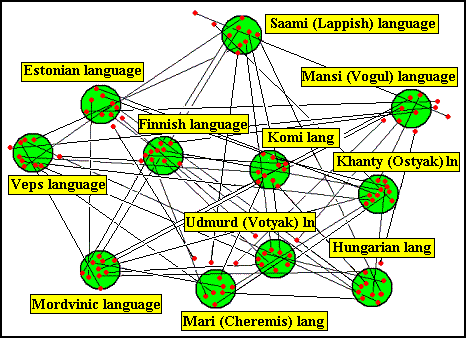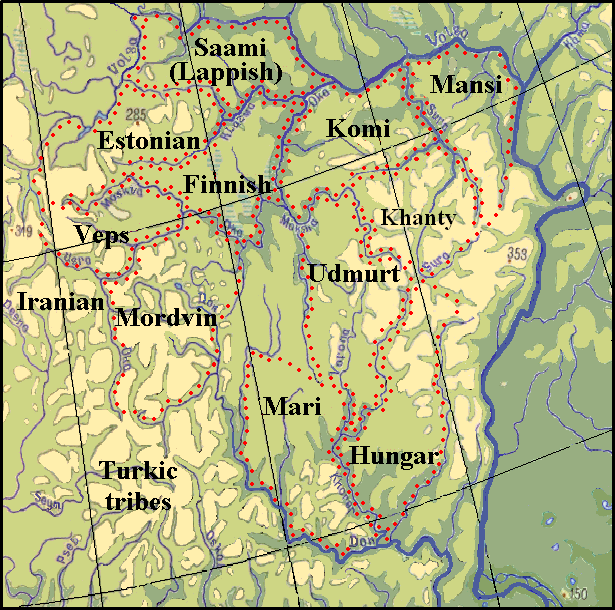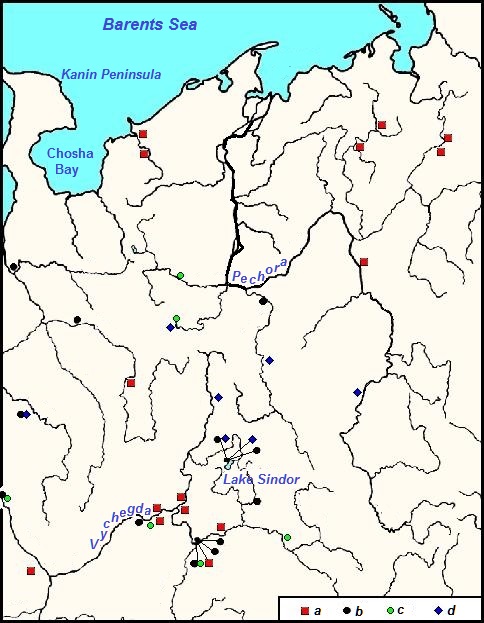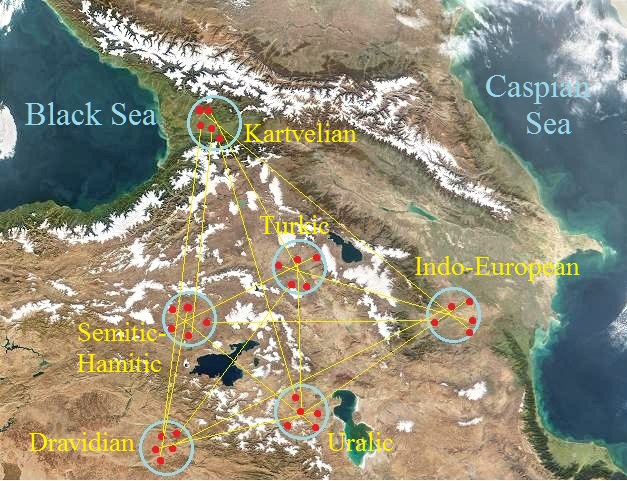The Finno-Ugric and Samoyed Tribes.
The space image below shows ethno-producing areas, defined by the graphic-analytical method, where the proto-languages, attributed to the Nostratic, which of them Proto-Uralic is, where arisen. In this section, we will analyze in more detail how the place of formations of the distinct Finno-Ugric languages, that is, the areas of the settlements of their first speakers determined by the graphical model and verified by other means.
NASA space image of the cradle of humanity with designated areas of formation of the Nostratic languages.
While preparing the table dictionary for the Finno-Ugric languages lexical material was taken out of the etymological dictionaries of the Uralic languages (A. ANTE AIKIO. 2020), the Finnish language (А. HÄKKINEN KAISA. 2007), Komi language (А. LYTKIN V. I., GULAYEV E.S., 1970), Udmurt (A. ALATYREV V.I. 1988) and Hungarian languages (A. ZAICZ GÁBOR, 2006), and bilingual dictionaries of other Finno-Ugric languages. The data of the etymological dictionaries had to be supplemented largely just by these dictionaries because editors of etymological dictionaries do not always give all matches for several Finno-Ugric roots. In some cases, these matches have not yet been found. The built graphical model of Finno-Ugric kinship relations made it possible to carry out targeted searches. For example, in the Finnish etymological dictionary of Finnish, the word konnti "a bark box for wearing on the back" is connected only with Mansi and Khanty words. However, between the areas of formation of these languages and the Finnish area are also areas of the Komi and Udmurt languages. Similar words should also exist in these languages, for otherwise, it is impossible to explain the presence of lexical matches between the Finnish and Ob-Ugric languages. Searches brought the expected results: Komi kud and Udm. kudy – both "basket". Such findings make it possible to clarify not only the model of kinship but also the patterns of the phonology of the Finno-Ugric languages. Another example is from the etymological dictionary of the Hungarian language, where FU root *aŋa- "to open" has matсhes only in Hung. old, Fin. avaa- "to open", Mord. anksema "ice hole, wake", Khant. aŋe "to untie (a knot)". In the etymological dictionary of the Finnish language, these data are supplemented with the words Vepsian, Estonian, and Mansi languages, but with targeted searches were also found Mar. joŋgy "open place, glade", Komi yukmös, Udm. jukmes "wake". Such examples are many, though not very expressive. On the other hand, the search for single-root words is often limited following traditional views on the division of the family of Finno-Ugric languages. An example is Hung.oldal "side" to Khant. ăŋti and Mansi an't'əl "rib", while the word has the same origin as the Udm. urdes "side" and other similar. Such facts say that editors approached the matter not quite carefully, placing themselves with an entirely different purpose than to establish the true relationship between the Finno-Ugric languages. Therefore, the preparation of the table dictionary was long and laborious work. It is submitted in the section Etymological Dictionaries-Tables for different language families and groups.
Such Finno-Ugric languages as Finnish, Estonian, Veps, Komi, Saami, Udmurt (Votyak), Mari (Cheremis), Mordvinic, Khanty (Ostyak), Hungarian, and Mansi (Vogul) were taken for analyses. Later Karelian was added to this list, but its vocabulary showed that this language was developed on the same base as Finnish. We will not consider this topic in detail. The compiled table dictionary of the Finno-Ugric languages has 2234 isoglosses and 217 of them belong to the common lexical heritage. (As the common words were considered that found at least in ten of eleven Finno-Ugric languages without Karelian). 125 words were voted as loan-words. Calculation results of mutual words are presented in Table 4.
Table 4. Quantity of mutual words in pairs of the Finno-Ugric languages.
| Lang | Fin | Komi | Udm | Est/ | Mari | Khant | Veps | Hung | Mansi | Karel | Mord | Saam |
| Fin. | 959 | |||||||||||
| комi | 396 | 875 | ||||||||||
| Udm. | 353 | 694 | 872 | |||||||||
| Est. | 724 | 313 | 288 | 802 | ||||||||
| Mari | 355 | 472 | 520 | 292 | 790 | |||||||
| Khant | 262 | 404 | 381 | 195 | 308 | 751 | ||||||
| Veps | 614 | 250 | 230 | 560 | 252 | 156 | 709 | |||||
| Hung | 246 | 380 | 389 | 190 | 356 | 426 | 156 | 672 | ||||
| Mansi | 234 | 346 | 327 | 174 | 245 | 541 | 136 | 367 | 663 | |||
| Karel | 639 | 241 | 207 | 359 | 218 | 148 | 511 | 150 | 132 | 652 | ||
| Mord | 362 | 288 | 312 | 328 | 359 | 184 | 306 | 200 | 148 | 257 | 596 | |
| Saami | 436 | 303 | 257 | 359 | 269 | 216 | 312 | 187 | 199 | 318 | 237 | 586 |
The model of relationships for the Finno-Ugric languages was built on these data and is presented in Figure 7.

Figure 7. The graphical model of the Finno-Ugric language relationship.
The corresponding territory for this model was found in Eastern Europe within the Volga-Don-Interfluvial area and in the Oka River's basin, where, according to the traditional opinion, the habitats of Finno-Ugric peoples were once situated, although the Finno-Ugric Urheimat is considered to be near the Urals (see the map on figure 8).
The areas of formation of distinct languages are mainly limited by large rivers. The area of the Finns lies between the Oka and Klyazma Rivers. To the west of them, between the Moscow River and the Oka to the Ugra River, was the area of the Veps, and the Estonians dwelled north of the Finns and the Veps between the Upper Volga, Upper Moskva River, and upper Klyazma River. Two rivers with the same name Nerl separated the Estonia area from the area of the Lapps, which was limited from the north and east by the Volga, and from the south by the Lower Klyazma. To the south-east of the Lapps, the Komi language formation area was located; this area in the west was bounded by the Oka River, in the north by the Volga, in the east by the Sura River, and in the south by the Moksha and Alatyr Rivers. The area of the Mansi was between the Volga and Sura Rivers on both banks of the Sviyaga River. The Moksha, Sura, and Alatyr Rivers limited a small area of the Khanty, and the Udmurts inhabited the area along both banks of the Vorona River between the Moksha, Tsna, and Khoper Rivers. The Magyar area was almost entirely limited by the Khoper and the Medveditsa Rivers, and the Mari area – by the Don, Voronezh, and the low Khoper rivers. Finally, the Mordvins inhabited a quadrilateral, bounded in the west and north of the Oka, in the east by the upper Don, and in the south by the Sosna River.

Fig. 8. The map of Finno-Ugric habitats.
Total Finno-Ugric territory limited by the Volga and Don Rivers, as powerful water hazards. Only Mordvins moved to the right bank of the upper Don, which is where it is easy to overcome, and came close to the Indo-European settlements. As in the Indo-European area, the whole Finno-Ugric territory too has "empty" areas. They, at least, two – to the south of the middle Oka and between the Volga and the Medveditsa. We can assume that a Finno-Ugric tribe, known as the "Meschera" populated the first "empty" area in the neighborhood with Finns, Mordvins, and Cheremis. You can also assume that the chronicle tribe Meria had its area between the Bityug and Voronezh Rivers, and then the ancestral lands of the Mari would be limited by the Bityug and Khoper Rivers (or vice versa). The assumption of the close linguistic affinity of these ethnic groups and, accordingly, their common Urheimat, is based on the similarity of ethnonyms Meria and Marie, which can be considered phonetic variants of the same word. As for other Finno-Ugric tribes, we must assume that they were the remnants of peoples who migrated to new places, and their languages, as well as Karelian, are languages of higher order concerning the rest of Finno-Ugric. No data for any assumptions for identifying the area between the Volga and the Medveditsa Rivers.
The proposed localization of ancient Finno-Ugric territory can be confirmed by paleobotany if it can be compared with the geographical dissemination of some plants having common Finno-Ugric names. While it is possible to draw for this purpose only the name and the geographical dissemination of oak. Almost all the Finno-Ugric languages have a name similar to Slavic: Fin. tammi, Est. tamm, Mar. tum, Erzya tumo, Moksha tuma, Komi typy, Udm. tupu. In the etymological dictionary of the modern Finnish language, the original Finno-Ugric form of the word is defined as *tomo, and the possibility of borrowing from the Slavic is not considered despite the similarity to the Slavonic oak name (HÄKKINEN KAISA. 2007: 1268). However, other specialists have a different opinion:
Because the ancestral home of Finno-Ugric peoples was located in the taiga zone, where no oak, this word along with the corresponding realities was learned by Finno-Perm inhabitants only when moving them from the homeland to the territory occupied by Slavs (TKACHENKO O.B. 1990: 26).

The judgment is rather strange because the Finno-Ugric peoples were not settled on Slavic territory, but on the contrary, the Slavs were newcomers to the Finno-Ugric lands, ie Finno-Ugric peoples were familiar with oak before contact with the Slavs and, therefore, must have had for this tree own name. Now northern border of oak stretches from St. Petersburg to about the latitude of Yekaterinburg, ie passes somewhat north of the Upper Volga, and the beyond Urals, oak is really absent.
At left: Quercus robur (oak) dissemination. Fig. 74 from the site "Forest library".
Thus oak was grown really on the territory of the Finno-Ugric peoples. On the other hand, as oak is absent in most parts of the Urals, the Finno-Ugric peoples could not have settlements in the Urals and beyond it. If the similarity of the Slavic and Finno-Ugric names of oak needs an explanation, then most likely, the word is a substrate protoform of a Paleo-European language.
Areas of forming Samoyed languages, which include the Nenets, Enets, Nganasan, and Selkup languages, is uncertain. In ancient times, Samoyed languages were more numerous (Mator, Karagas, Kot ones else). If the question is about the genetic relationship of the Finno-Ugric languages, at least the initial settlement of their speakers would have to be somewhere near the Finno-Ugric peoples. There are on the map of Eastern Europe free place north of the upper Volga. It could be assumed that here, based on the population of the Laponoid anthropological type and its language, ethnic groups of the Samoyedians also formed in certain geographical areas with clear-cut natural boundaries. In the Sami language, according to the testimony of many scientists, a powerful layer of substrate vocabulary (up to one-third) of unknown origin has been preserved (FROMM HANS, 1990: 16). It is assumed that this vocabulary is of Samoyed origin, but there is also another view: "the idea of the Samoyed origin of the substratum vocabulary of the Sami language does not stand up to criticism" (NAPOLSKIKH V.V., 1990: 129).
However, according to Meinander, "In the vast territory of North-Eastern Europe from the Urals to the Gulf of Bothnia, from the Arctic Ocean to the Kazan-Riga border, there are no linguistic traces of other languages, except for the Finno-Ugric and Samoyed languages". (MEINANDER C.F. 1974: 19). Under such circumstances, the closest to the truth was, obviously, Simchenko, when he wrote about the common substrate for the Sami and Samoyed languages:
… the substratum elements of the Sámi language, by their nature, cannot be considered direct borrowings from the Samoyed languages. In this case, the identical phenomena of the Samoyed and Lappish languages should be explained by the presence in the composition of these peoples of a single Ural-speaking ancient substrate, which had a linguistic influence on both the Samoyed and the Northern Samoyeds (SIMCHENKO Yu.B. 1975: 167).
Comparison of archaeological, linguistic, and anthropological data confirms, in general, the correctness of the hypothesis of the existence of a single ethnic substrate in the ethnic history of the Arctic and Subpolar regions of the Old World (SIMCHENKO Yu.B. 1975: 184).
Since we now know that the Uralians (Finno-Ugrians) were not aborigines of Europe, then, accepting Simchenko's conclusion about the common substrate in the Sami and Samoyed languages, it should be assumed that the unknown substrate in these languages is part of the vocabulary of the Eastern proto-language of people of the Laponoid type, a single ethnic group that in the Mesolithic inhabited North-Eastern Europe (see the section "The Anthropological Type of the Autochthon Europeans").

At right:Early Neolithic sites of the European North-East in the basins of the Vychegda, Pechora, and Mezen rivers
a – sites without clayware
b – the group of Chernyi Bor
c – the group of En'ty with with trapezoids of En'ty type
d – sites with clayware of "Kargopol" type
The map copies the original (VOLOKITIN A.V., KARMANOV V.N. 2004: 6. Fig. 1) without specifying the exact location of the sites.
If the Samoyedic languages were formed based on this eastern paleo-European proto-language under the strong influence of the Finno-Ugric languages, then obviously after the settlement of the Volga-Oka basin some powerful group of Finno-Ugrians crossed the Volga, mixed here with the descendants of the Volga-Kama Mesolithic cultures in the Vyatka basins and Vetluga, which existed here in the 7th – 4th millennium BC and had a significant impact on the language of the local population. The connection between the Early Paleolithic sites indicated on the map above and the Late Mesolithic sites has not been established, therefore "we should talk about cultural traditions, the roots of which are most likely outside the boundaries of the territories in question" (ibid, 13).
With a higher culture of management, the Finno-Ugrians undoubtedly had a more developed language, therefore, not only vocabulary but also whole grammatical categories could be borrowed. In addition, the cultural influence of the Finno-Ugrians on the local population manifested itself in Samoyed mythology. For example, in Nenets folklore, there is a legend about a flood, during which people fled on a large raft, on which they took one representative of each animal species. God-demiurge Num gravitates towards Proto-Samoyed mythology, the analog of which is the Khanty Num-Torum. Later, with the widespread settlement of the Finno-Ugrians in the basins of the Kama and Sukhona rivers, the previously formed Samoyed tribes were partially assimilated among the arrivals, and most of them retreated to the north and east beyond the Urals, retaining their ethnic identity. The first wave of Samoyed settlers beyond the Urals could eventually give rise to the development of the Yukaghir ethnic community, whose language can also be related to the Finno-Ugric (SIMCHENKO Yu.B. 1975: 176; IVANOV V.V. 1990).
Knowing the habitats of the Nostratic-speaking people in Eastern Europe, we can talk more specifically about the connections of Finno-Ugric languages with other Nostratic languages. Linguists and ethnologists unanimously suppose that the contacts between Finnish people and the Indo-Iranian part of the Indo-European community were most active and continual (KHALIKOV A.Kh. 1990.: 53). Iranian-Finno-Ugric language connections were studied by many well-known specialists (A. ABAYEV V.I. 1965; ABAYEV V.I. 1981; GEORGIEV Vl. 1958; KORNILOV G.Z. 1973; HARMATTA J., 1981; BLAŽEK VACLAV, 1990; FROMM HANS, 1990; GULYA JANOS, 1990; KOIVULEHTO Jorma, 1990). As a result, a view was formed that the Iranians no longer contacted speakers of ancient Eastern Finnish dialects than Uric ones. V. Abaev, for example, specifically focused on the correspondences of the Ossetian language with Hungarian, Udmurt, and Komi, and believed that Ossetian has significantly fewer Baltic Finnish matches than Permian and Ugric ones. Vaclav Blažek searching Finno-Ugric-Aryan lexical parallels also turned more to the Ugric and Permian languages than to the Baltic Finnish. However, no doubt were that the greatest influence of Türkic languages was provided to the Mari, Hungarian, and also Udmurt, and Mordvinic languages (FEOKTISTOV A.P. 1965, 331-333), and it can be explained rightly by close contacts of the ancient Finno-Ugric peoples with the Turks. The habitats of the speakers of the Indo-European, Finno-Ugric, and Turkic languages were situated in such a way that (Mari) Cheremis and Magyars, indeed, of all the Finno-Ugric peoples, were the nearest neighbors of the Türks
Staying within the vocabulary and statistical studies we can quantify connections of the Finno-Ugric languages with individual Indo-European and individual Turkic. Based on Etymological table-dictionaries of these three language families, was compiled the summary table of lexical matches between Indo-European, Finno-Ugric and Turkic languages. The whole table has more than 700 matches. Then the supposed Nostratic fund, to which lexical matches present in all three groups of words were assigned, was withdrawn from it. Let us briefly consider the Indo-European and Finno-Ugric matches. Their total number was 208 items, and the Iranian, Greek, Indian, Germanic, and Baltic languages had matches at most. When it became clear that Iranian-Finno-Ugric parallels are the most numerous, then an additional search for separate Iranian-Finno-Ugric relations was made, ie without correspondences in other Indo-European languages. Several dozen of them were found, but some of them come from more recent times, therefore they were separated into two chronological groups. The criterion for the division was the number of Iranian languages, which had matched Finno-Ugric words. If the number of languages was three or more, it was suggested that the word belongs to the time of the common Iranian language. If the word was found in one or two Iranian languages, then it was referred to as the time when common Iranian has been split into separate languages. The words of the first group were also included in the table and the total number of matches increased to 235 (hereinafter supplied exact numbers are only indicative, since the lexical material is constantly refined, and the table itself is undergoing some changes). Current table lexical correspondences can be found on the Internet.
After that, the number of common words of the Indo-European languages, having the largest number of Finno-Ugric matches, was estimated with individual Finno-Ugric. The results of the calculations are shown in Table 6. The second column represents the total number of common words of each Indo-European language with all the Finno-Ugric. The Finno-Ugric languages are arranged in order of their distance from the Indo-European space, and the Indo-European ones did respectively from the Finno-Ugric. We can see for the Finno-Ugric languages, that the number of common words in the language pairs as a whole are decreasing at the removal of their areas. As an example, the name of the daughter in the western Finno-Ugric languages (вепс. t’ütar, Erz. тейтерь, Est. tütar, Fin. tytür), which corresponds to PIE *dhugheter “a daughter” (Ger. Tochter, Gr. τυγατηρ, OInd. duhitar etc.)
It is natural that the Iranian languages have most of all matches with Finno-Ugrian words. The Indian language has them much less than Iranian has, and even than Greek, and the difference between the Baltic and Germanic languages is within the statistical error. An explanation of these facts can be such. The Indo-Aryans were among the first who left their ancestral seats and had no more contact with the Finno-Ugric people, whereas the Iranians were neighbors with them for a long time further. The Greeks in their mass also left their ancestral home, but some of them remained on the territory of Eastern Ukraine (see. Ancient Greeks in Ukraine), what was resulted in borrowing Greek vocabulary into Mordvinic languages. Later, part of the Balts had good contact with the Finno-Ugrians, who moved to the left bank of the Dnieper. However, their language is unknown because they were assimilated by the local population. The ancestors of the Lithuanians and Latvians did not have close contact with the Finno-Ugric peoples at that time.
Table 6. The number of common words in the Indo-European and Finno-Ugric languages.
| Comm. | Veps | Mord | Mari | Est | Fin. | Saam | Udm | Komi | Hung | Khanty | Mansi | |
| Iran | 171 | 98 | 88 | 58 | 83 | 80 | 50 | 43 | 34 | 31 | 33 | 21 |
| Ind | 114 | 54 | 59 | 45 | 58 | 57 | 35 | 33 | 24 | 25 | 23 | 14 |
| Greek | 136 | 69 | 80 | 49 | 66 | 63 | 36 | 42 | 31 | 23 | 27 | 17 |
| Balt | 120 | 63 | 60 | 38 | 65 | 58 | 37 | 38 | 30 | 19 | 26 | 15 |
| Germ | 120 | 56 | 59 | 41 | 61 | 56 | 33 | 34 | 33 | 21 | 26 | 17 |
Localization of habitats of the speakers of the Nostratic languages can help the study of cultural relations of the population of Eastern Europe during the Chalcolithic and Bronze Ages. This topic is concisely outlined in Section The Language and Cultural Contacts of the Population in Eastern Europe and can be developed further.
It can be the fruitful connection of individual Finno-Ugrik habitats with available Finno-Ugric place names, which can even suggest ways of their later migration to their lands at present. You can find many place names of Finno-Ugric origin in Russia, which remained here from the For-Russian period (GORDEYEV F.I., 1990, 60). Many of them can be decrypted using several languages, but in some ethnic-producing areas place names can be decrypted just by using those languages in which here were formed. In some cases, chains of names of individual nations mark migration paths from their ancestral home to the modern-day territories. (See. Map below)
Finno-Ugric place names on ethno-producing areas and migration routes of Finno-Ugric peoples.
The boundaries of total Finno-Ugric territory and boundaries of individual areas are indicated by black lines. At the same time, they are the rivers, if they have no interpretation using the Finno-Ugric languages. Place names left by individual Finno-Ugric peoples at times of formation of their primary languages are indicated by different colors. Finnish – blue, Estonian – red, Hungarian – brown, moksha – light violet, Komi – light blue, Udmurt – green, etc. Localities designated by starlets, rivers – by lines.
There are on the map names of Bulgarian origin marked by yellow squares, left by creators of Fatyanovo culture, who came from the banks of the Dnieper along the Desna River and upper Oka River. The placement of names shows that the aliens did not mix with the local population for a long time and forced them to migrate in search of new places of settlement.
Prehistoric Finno-Ugric place names are considered more detailed separately (see Section Finno-Ugric Place Names of Ancient Times.)


